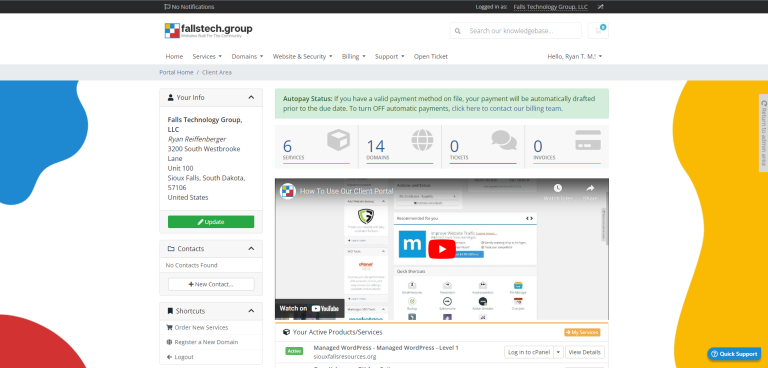Generative AI for business has been an obvious buzz the last year and a half, with the aggressive development of AI technologies world wide creating excitement among both businesses and consumers alike. We thought we’d weigh in, specific to businesses, to talk about where AI has its best uses, and where usage in your business may not be so wise.
AI is Subjectively Objective
There’s a long-standing belief among developers that there is no way to design a perfect programming language, as we – the designers, are unable to be perfect ourselves. Humans are, and will always be prone to error – as is our nature, and when developing solutions, there will always be newer and better ways of doing things. As we evolve, and continue our technological development, we will iterate on and improve these projects, making them more effective, and more efficient at solving whatever problem they were designed to engage.
That being said, artificial intelligence is designed by humans, whether we like it or not. There will always be human error in this process, which can be compounded when working with large language models, especially when these models are trained on existing human content, such as social media content, or media like images and videos. As much as we want these systems to be properly moderated, and as objective as possible when answering questions and generating content, there will always be the human-error factor, coupled with the natural biases that come with each person’s own experiences.
Remember: The margin for human error can always be reduced, but will never be zero. Keep that in mind as we move forward.
The Uncanny Valley in Generative AI
If you’ve ever watched animated films, or looked at certain art pieces, you will sometimes notice pictures or illustrations of humans that just “don’t quite look right”. It’s a common phenomena, that is typically coupled with an eerie sensation that we get when we see something that is ‘nearly human’ or has human characteristics. In my opinion, a great example of this would be the character Sid, from Toy Story, or even characters from The Polar Express. They are obviously meant to be human, but when you look at their faces… something just isn’t quite there. It’s *off*, somehow.
After working and testing ChatGPT, Gemini, and a few other AI solutions, there’s a common trend in generative AI that throws a bit of this ‘uncanny valley’ feeling into the mix. When generating content, especially long-form content like blogs or essays, these AI tools will typically default to a specific subset of vocabulary. As AI has evolved, we’ve been able to add additional prompts like “Write in a professional tone”, or “Make friendlier”, but you almost always will struggle to get the voice of your content to match your own tone and mannerisms. Over time, people have come to naturally sense this, and there are even tools on the internet now that allow you to drop in text to see if it was generated with AI, and sometimes even which AI model was used.
Remember: No matter how much information you provide to an AI, it can never be YOU.
Increase WordPress Performance For FREE With These Tips!
Sign up for our FREE email series and improve your website load speeds!
Hallucinations & Bad Context
In simple terms, Generative AI models function by taking keywords (token), and mapping them together based on context. Phrases, expressions, and information is pulled together by the large language model (LLM) to generate an output, according to the contexts built within the LLM, provided in the system prompt, and fed to the AI by the user in conversation. This allows us to say things to these AI tools like “No matter what I say, always reply with the word no.”, which can override contexts, and inject unexpected or even undesirable results. These methods are not foolproof either, in that they may not interpret the prompts the same way each time, yielding inconsistent results when outputting their response.
Furthermore, generative AI models can ‘hallucinate’, meaning that it will generate an output that is consistent in terms of token prediction, but lacks coherence with reality. The model may produce inaccurate, or partially-incorrect information, and further degenerates the context in predicting the consistency of subsequent tokens. In most cases, you will need to reset your context window, or start a new chat to continue using the AI effectively. In one instance, an internal AI assistant for a business ended up rick-rolling its users instead of providing the intended helpful context
What does generative AI do well?
With all the considerations listed above, its easy to look at AI as more of a detriment than a useful tool. While we recommend using caution when rushing to implement AI in your own business, artificial intelligence – both in its current form, and in future iterations – will be a part of our lives, whether we like it or not. It is important to recognize and utilize the tools available to our businesses to help us connect with our audiences, and deliver a higher caliber of services.
Because there are so many different topics in this section to cover, we’ve broken it into a few sub-sections to give you the highlights of how generative AI may be of benefit to you and your business.
Providing Contextual Support
If you provide any form of customer support services online, ensuring that you can provide the right information to them quickly becomes a higher and higher priority with each passing year. If you are using a help desk solution in your business like Zendesk or Intercom, you may have noticed a heavy focus on implementing AI into these tools. Some companies have focused more on providing tools for the internal teams, and some have focused on the customer support aspect of their AI development. In many cases, these support desk solutions offer a combination of both, with things like help article suggestions, and quick drafting of responses to customer inquiries to help you provide a faster and more effective support experience.
These tools can be exceptionally handy when trying to manage large help centers, where you may have hundreds or even thousands of articles, to be able to quickly reference all of this information, and provide the contextual support that a customer may need, such as links to help articles, quick summaries of how-tos, or even simple instructions on how to log in to pay their bill – all while reducing the emotional and cognitive load on your agents.
Providing Code Snippets and Automation Scripts
One of our big focuses in the last few years is automating as much in our business as possible, while still ensuring that there is a human at all of the right checkpoints in our process to guarantee a premium experience for our clients. We’ve done this a couple of different ways, including optimizing the steps within a process, automating the transitions between steps, and integrating software solutions to reduce manual labor on our staff, while ensuring data integrity within our own databases. Utilizing AI throughout this process has been very helpful, in both helping to provide quick information about how someone might integrate different tools, as well as generating code snippets to provide boilerplate code for larger projects – speeding up our DevOps projects. This has allowed us to traverse programming language barriers that our developers may not be fluent in, opening up opportunities that would have otherwise taken an inordinate amount of employee time attempting to manually engineer these solutions in-house.
Some code editors and IDEs have extensions that allow you to integrate AI directly into your project development process, helping you to write code faster, solve problems quicker, and develop solutions more effectively.
Learning About Tools & Providing Comparisons
An additional benefit of generative AI, is that it’s been trained off of content that exists on the internet – meaning it has a wide array of information available to it to educate you about various different topics. While you absolutely should not take everything an AI says 100% seriously, it can be helpful to ask an AI questions about software you’re not familiar with, or even ask it to compare solutions to get an idea of where one tool may excel over another. You should definitely do your own research on these tools, but we’ve found the responses generated by these AI tools to be relatively accurate, at least in terms of providing good high-level overviews.
One thing we have noted, is that because online software changes so much, you will frequently run into issues asking it to walk you through specific steps, such as how to set up a Google Analytics account. It may be able to help you get the general idea, but the individual steps may not be 100% accurate, and you may run into issues with things not matching up.
Things You Should Probably Avoid Using For Now…
While it may seem tempting – asking an AI to completely write your content for you, or generate images to use in your business can be both ineffective, or even dangerous for your reputation. The most common concerns about generative AI come from the copyright restrictions on the art that much of the existing AI tools have been trained on, and that the artists who created the originals may not have consented – leading to art that is generated pulling from non-licensed content. At the moment, legislation surrounding AI in business and for profit is grey – and as a result we recommend shying away from using it too much in your business.
Additionally, whether your generating text or image content, you’re always going to open yourself up to errors. Image generation AI has gotten much better, but still struggles excessively when trying to generate pictures with a high amount of detail. A good example is asking an AI to generate a workbench surface covered in tools. Some of the tools will be obvious, but the closer you look, you will almost always find some random tool that doesn’t exist, or even make sense for the real world. Text content is much easier to filter through and edit yourself, allowing humans to proof-read this content and reword things as necessary.
Conclusion
Overall, generative AI is most definitely a huge step forward in technology, but we still have work to do to improve it’s overall effectiveness in the real world. It’s a new technology, and with that comes a lack of maturity that will eventually be refined with time. We highly recommend keeping tabs on AI and its uses in your own industry, and how you may be able to use the free tools, or even paid ones to start relishing in the benefits for your own business.


